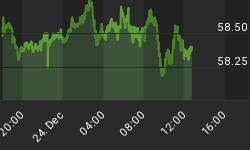CNBC EUROPE
LET'S LOOK AT THE FTSE

Last week I indicated the index had hit a short term high at the technical point of the "last low before the final high" and would likely consolidate the move up with a small correction-normally a first-degree counter trend of three or four days. That did occur and the index bottomed at 50% of the range. I believe this index is starting the process of a sideways pattern that will run for at least 6 months. There is a cycle over this coming weekend so Friday or Monday could produce a turn. The most significant time cycles come out September 1st to 5th. If the index is not at a new high by September 11 then that date can produce a high and the index will go back to test the lows and could marginally pierce them and then give another run at the highs.
LET'S LOOK AT THE S&P 500 INDEX-WEEKLY CHART

The index is up to the price level of a previous high and can represent resistance while in sideways pattern. This pattern of a possible "lower double top" can also represent a complete distribution pattern but since this index will takes a minimum of 6 months (180 calendar days) to form a top and could be as long as 240 or 270 days this is far to early to look for an important top. I have been calling for a correction to start from this time period. If the Fed stops the rate rises Tuesday, then an exhaustion is possible this week. If they don't then a correction is likely. The "time" period of September 11th 2006 is starting to show up as significant in the vibrations through "time" and will be a 5 year anniversary date. A move up to that date would indicate the start of a correction.
I would still keep an eye on the oil market as that has had an effect on stock indexes. I thought we could see a move up into the 14th.
CNBC ASIA
LETS LOOK AT THE US DOLLAR INDEX

The chart is monthly and shows the trend for the past 20 years. You can see the index bounced up from the "obvious" 1995 low. You can also see by the angle of descent the move into the last low was at a 50% faster rate of decline than the trend into the 1995 low and created a capitulation at the "obvious low." The trend down was exactly 3 and a half years and the rally was one year and sufficient in time to resume the downtrend. IT is very important the index could only retraced ¼ of the move down and stopped at a previous high. Leaving a lower double top while trending down and a valid technical pattern to resume the trend. The ¼ retracment is a very weak retracement considering the magnitude of the move down in both price and time and keeps the very fast downtrend intact. And when considering the speed of the downtrend, the next move down should go to a minimum of 73 in the index. This is a scary pattern of trend in this index due to the small retracement. From a purely technical standpoint, if there was a panic of some sort the index could go to 67. I also don't see a low until June 2007 +- one month. But considering it may take 6 months to form a base that time in June may not be as far away as it appears.
NOW LETS LOOK AT THE HANG SENG INDEX

The chart is a weekly view of the entire bull campaign. Since the last low bottomed at the price level of a previous low there is now a probability this could be starting a sideways pattern for the next six months as I believe a lot of the stock indexes are now doing. If not then I have held a theory that important highs and lows will become or better said, can become 50% marks into the future. You can see the December 2004 high and the October 2005 low are approximately at the same price level and would be considered technically important. So if my theory applies to this circumstance then that price level should become a 50% mark in the future and yields a price objective or target of 17.8 to 17.9 for the index. I hope everyone say the "TAS" setup at the last high. Remember the third day against a spike. A time vibration is indicating September 11 could be significant.
This week should establish the trend in the Australian stock indexes but today's inside day didn't help. The index is on hold until the U.S. rate situation is resolved.
















